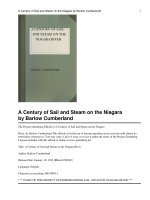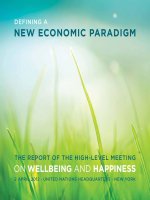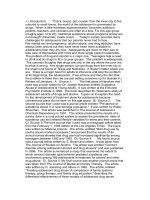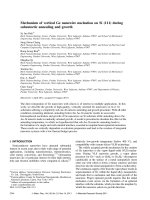acts of god and man ruminations on risk and insurance
Bạn đang xem bản rút gọn của tài liệu. Xem và tải ngay bản đầy đủ của tài liệu tại đây (1.74 MB, 303 trang )
acts
of
god
and
man
michael r. powers
Ruminations
on Risk
and
Insurance
ACTS OF
GOD AND MANacts
of
god
and
man
michael r. powers
Ruminations
on Risk
and
Insurance
Columbia University Press
Publishers Since 1893
New York Chichester, West Sussex
cup.columbia.edu
Copyright © Michael R. Powers
All rights reserved
Library of Congress Cataloging- in- Publication Data
Powers, Michael R.
Acts of god and man : ruminations on risk and insurance / Michael R. Powers
p. cm.
Includes bibliographical references and index.
ISBN ---- (cloth : alk. paper)—ISBN ----
. Risk (Insurance) . Risk management. I. Title.
HG..P
—dc
Columbia University Press books are printed on permanent and durable
acid- free paper.
is book is printed on paper with recycled content.
Printed in the United States of America
c
References to Internet Web sites (URLs) were accurate at the time of writing. Neither
the author nor Columbia University Press is responsible for URLs that may have
expired or changed since the manuscript was prepared.
To the memory of my father,
John Nolan Powers
Foreword ix
Preface xi
A c k n o w l e d g m e n t s x v
PART 1. Living with Risk
1 The Alpha and the Omega of Risk The Signifi cance
of Mortality
2 Into the Unknown Modeling Uncertainty
3 The Shapes of Things to Come Probabilities
and Pa ram e ters
4 The Value of Experience In de pen dence and
Estimation
5 It’s All in Your Head Bayesian Decision Making
viii CONTENTS
PART 2. The Realm of Insurance
6 Aloofness and Quasi- Aloofness Defi ning Insurance
Risks
7 Trustworthy Transfer; Probable Pooling Financing
Insurance Risks
8 God- Awful Guessing and Bad Behavior Solvency
and Underwriting
9 The Good, the Bad, . . . The Role of Risk
Classifi cation
10 . . . And the Lawyerly Liability and Government
Compensation
PART 3. Scientifi c Challenges
11 What Is Randomness? Knowable and Unknowable
Complexity
12 Patterns, Real and Imagined Observation
and Theory
13 False Choices and Black Boxes The Costs of
Limited Data
14 Nullifying the Dull Hypothesis Conventional
Versus Personalized Science
15 Games and the Mind Modeling Human Behavior
Notes
Author’s Editorials and Other Writings
Bibliography
Index
It is a plea sure to write a foreword for this book of both scholarship and
humor. It factors in the various concepts of risk, but provides both theory
and practical guidance on those “aloof risks” suitable for insurance. e
author manages to create a text for students of insurance while raising the
deep philosophical problems in the formulation and application of proba-
bility theory.
e division of the opus into three segments on “Living with Risk,”
“ e Realm of Insurance,” and “Scienti c Challenges” is most appropriate
to providing context and width of view, yet motivating an appreciation for
the institution of insurance as it is together with its many operational
problems in a dynamic, evolving world. e book uses simple yet basic
models to open the eyes of those who wish to appreciate the many subtle
paradoxes of probability together with the many applied problems of how
one goes about insuring risk. At the end of each chapter an imaginative
and o en humorous dialogue is presented that helps to drive home a cen-
tral point of the chapter. For those who read with care an estimate of the
author’s intended lifespan can be obtained.
Uncertainty surrounds us. Many humans cycle through obliviousness
to risk when immersed in the habitual routines of everyday life, until a
non- routine event shatters those routines. Complacency can easily be
x FOREWORD
displaced by formless fear and even panic. e appreciation of both exog-
enous risk and strategic risk is manifested here. us, the author covers
the intersection of insurance with not only probability and statistics, but
also phenomena arising from games of strategy.
Insurance theory, economic theory, accounting, and nance have in
many ways grown further apart as disciplines specialize more and more
and the sub- disciplines insulate themselves from their companions, trad-
ing in breadth for depth. Unfortunately we need both. A great insurance
expert, nance or accounting specialist, or economist needs not merely to
have a deep understanding of technique and theory but an appreciation of
how his or her expertise links with others; and above all a sense of context.
ere is an old canard in some circles that comes in the form of a
riddle:
Q. Why did Joe become a statistician?
A. Because he did not have the charisma to become an accountant!
Fortunately this is a libel by those who understand neither the basic
roles of probability and statistics, nor the critical role of trying to keep the
books consistent in any form of dynamics that is always present in the eco-
nomics of everyday life.
e book ahead of the reader is a monument to the proposition that
wit, humor, and scholarship can be combined to provide insight and pro-
mote interest in a domain where the accusation of drabness or dullness of
the topics covered is usually a self- accusation by the claimant. In spite of
the great advances on the philosophical underpinnings of probability since
Hume, many of the questions of the last sixty years are still open questions.
e third section rightly is labeled “Scienti c Challenges.”
e book at one point raises the question as to how one mea sures hap-
piness. I cannot guarantee that happiness and fun have similar mea sures,
but in keeping with thought on science and mea sure ment I am happy to
state that reading this book is fun and the mixture of wit, scholarship, and
nonconventional practicality provides a deep ser vice to the topics covered.
Martin Shubik
Branford, CT
April
e present volume o ers a journey into the world of risk and the ways in
which this concept, and our perceptions of it, a ect various aspects of hu-
man life. Before embarking on this adventure, there are a few things that
need to be mentioned.
First, I want to state clearly that the book’s primary focus is those risks
traditionally viewed as “insurance” perils: earthquakes, storms, res, inju-
ries, illnesses, the s, assaults, and various types of liability. Described as
“aloof” or “quasi- aloof” risks, these sources of uncertainty can in uence
other nancial risks over time, but are themselves largely immune from
the e ects of such “non- aloof” risks as stocks, bonds, commodities, loans,
and other nancial instruments.
Admittedly, the decision to focus on insurance risks is somewhat a
matter of personal taste. However, I believe this preference is well founded in
the experiences— and especially exigencies— of human existence. A er all,
art does imitate life; and when Daisy Buchanan’s tragic automobile acci-
dent seals Jay Gatsby’s fate, there is nothing the bond trader Nick Carraway
can do about it.
Second, I would note that the word risk, taken as a noun, possesses nu-
merous meanings, even when con ned to its technical uses within the elds
of risk management and insurance. For example, the term can refer to:
Daisy and Gatsby danced. . . . Then they sauntered over
to my house and sat on the step for half an hour, while at
her request I remained watchfully in the garden. “In case
there’s a fi re or fl ood,” she explained, “or any act of
God.”
—NICK CARRAWAY (NARRATOR OF F. SCOTT FITZGERALD’S
THE GREAT GATSBY, 1925)
xii PREFACE
• a source of uncertainty (“the risk from driving at high speeds is
unacceptable”);
• something exposed to uncertainty (“that automobile insurance
company underwrites more than , risks”);
• the probability of a given uncertain outcome (“the risk of a tra c
fatality is greater on the highway”);
• the anticipated magnitude of a given uncertain outcome (“the -
nancial risk of an automobile liability claim is great”); and
• the variability of the magnitude of a given uncertain outcome (“if
the members agreed to pool their collision losses, then each could
reduce his or her individual risk”).
Although each of the above meanings is perfectly acceptable in the ap-
propriate context, it is clear that the word risk is highly overworked. ere-
fore, in the interest of clarity, I will generally restrict its use to the rst
meaning— that is, a source of uncertainty— which o en will be taken to be
approximately synonymous with peril or hazard. For the other meanings,
alternative terms, such as exposure, probability, chance, average, expected
value, dispersion, standard deviation, variability, etc. will be employed.
Finally, I wish to emphasize that the book’s objectives are both to
challenge and to inform— and ideally, to achieve the latter by way of the
former. Although the topics addressed are broad ranging, they are more
eclectic than exhaustive, and their treatment more speculative than con-
ventional. At times, the ruminations are highly personal, brazenly citing
the author’s writings to the exclusion of competing views. Also, certain dis-
cussions are not only U.S centric, but also Pennsylvania- (and even Phila-
delphia-) centric, in deference to the author’s a liations with the Pennsyl-
vania Insurance Department and Temple University.
In substance, the book is intended to provide a bemusing starting
point for the consideration of an insurance- oriented science of risk that
possesses as much in common with physics, engineering, environmental
science, and medicine as it does with nance. Part , “Living with Risk,”
provides an overview of how risk impacts our lives, health, and posses-
sions, and then introduces the statistical concepts and methods necessary
to analyze uncertainty. Part , “ e Realm of Insurance,” explores the ex-
perience of risk from the perspectives of both policyholders and insurance
companies, as well as the role of government as both market regulator and
potential “insurer of last resort.” Part , “Scienti c Challenges,” o ers an
interdisciplinary investigation into the nature of uncertainty, employing
PREFACE xiii
ideas from physics, philosophy, and game theory to assess the fundamen-
tal di culties of a science of risk.
Naturally, I would hope that some course instructors— at least the
more iconoclastic— will nd the work a useful supplement to standard risk
and insurance materials at both the undergraduate and the graduate level.
To all readers of the volume, regardless of background or predilection,
Ipromise nothing short of the giddiness experienced by Gatsby’s other
accident- prone guest upon examining the books in his host’s library:
“[ ey’re a]bsolutely real— have pages and everything. . . . It’s a triumph.
What thoroughness! What realism!”
e publication of Acts of God and Man would not have been possible
without the inspiration, guidance, and support of many friends and col-
leagues. In this regard, I am particularly indebted to Verna Dreisbach
of Dreisbach Literary Management and Myles ompson and Bridget
Flannery- McCoy of Columbia Business School Publishing. I also would
like to take this opportunity to thank my mentors in the professional and
academic realms of risk, who have been unwavering in their generosity:
Lena Chang, Constance Foster, Moshe Porat, John Pratt, Martin Shubik,
and Kai Yu.
In writing the book, I have incorporated materials from certain prior
publications. ese include a number of collaborative articles and book
chapters, for which I am deeply grateful to my distinguished coauthors:
Zaneta Chapman, R. B. Drennan, Piyawadee Khovidhunkit, Edward
Lascher, Moshe Porat, omas Powers, David Schizer, Zhan Shen, and
Martin Shubik. In addition, several discussions are based upon a series of
editorials composed for the Journal of Risk Finance over the past few years,
and I would like to thank my colleagues at Emerald Group Publishing—
Kelly Dutton, Stephanie Grosz, Simon Linacre, Adam Smith, Sarah Rough-
ley, and Anna Torrance— for the opportunity to experiment with these
ideas.
xvi ACKNOWLEDGMENTS
To facilitate the citation of the above works as they appear throughout
the book, I have arranged them into a list, titled “Author’s Editorials and
Other Writings,” immediately following the main text. Each item of this
list is presented by date of publication and assigned a number (i.e., [], [],
[], etc.) for citation purposes. All other references are provided in the
Bibliography.
Finally, I would like to thank my wife, Imelda Powers, for her reinsur-
ance expertise and comments on the nal manuscript, as well as my col-
leagues Bonnie Averbach, Norman Baglini, and Siwei Gao for their com-
ments on an earlier dra . Naturally, all errors in the text are attributable to
chance alone.
ACTS OF
GOD AND MAN
1
Living with Risk
1
e Alpha and the Omega of Risk
e Signi cance of Mortality
At bottom no one believes in his own death, . . . in the
unconscious every one of us is convinced of his own
immortality.
—SIGMUND FREUD (REFLECTIONS ON WAR AND DEATH, 1915)
1
e relationship between human beings and the risks of their world is both
ancient and complex.
2
It is the stu of myth and literature as well as philoso-
phy and science. Wars, plagues, famines, oods, and earthquakes mark many
of the turning points of the Hebrew Bible, and Greek mythology provides a
generous reservoir of risk- related meta phors: Achilles’ heel, the Sword of Da-
mocles, Pandora’s box, the Lernean Hydra, etc. In modern times, epic
disasters— such as the Titanic, Pearl Harbor, Apollo 13, and Chernobyl— have
assumed their own roles in our collective psychology.
Today, problems of risk form the basis for insurance and other nan-
cial ser vices industries and are studied rigorously by scholarly researchers.
But regardless of how these problems are formulated and analyzed, I would
argue that they all ow from the same source: the specter of mortality. Like
a serpent coiled around the trunk and branches of the Tree of Life, the risk
of death squeezes at every aspect of human existence.
Downside Risk Versus Upside Risk
In recent de cades, we have come to believe that the course of biological evo-
lution on Earth was changed dramatically by chance encounters between
LIVING WITH RISK
our planet and approaching asteroids or comets. Instructively, these cata-
clysmic impacts— leading, among other things, to the extinction of the di-
nosaurs and the ascendancy of the mammals— point up one important as-
pect of risk: although the word generally has negative connotations because
of its association with destruction, it also can suggest positive, albeit uncer-
tain, developments. Like the Hindu god Shiva, whose destructive nature
paves the way for creation and growth, risks have their positive side.
e asymmetry between the positive and negative aspects of risk arises
because random change is more likely to damage than to enhance the care-
fully wrought equilibrium of the status quo, especially in the short run.
is is nowhere clearer than in evolutionary biology, where for every salu-
tary ge ne tic mutation there are countless lethal deviations. Nevertheless,
whether we see risk as primarily negative or as a balance between negative
and positive potentials is largely a matter of perspective. If I assume that a
human being’s life on Earth should be unending, then clearly I will see any
degree of mortality risk as negative. However, if I view each human being as
entitled to only the expected lifetime given by the actuary’s mortality table,
then I will acknowledge a reasonable balance between negative outcomes
(early deaths) and positive outcomes (late deaths).
When embedded in the nancial products of modern economic mar-
kets, risks naturally assume a degree of symmetry by way of the pricing
mechanism. Although an o ce building, taken as an isolated entity, is ex-
posed primarily to the pure (i.e., entirely negative) risks of re, wind, etc., the
purchase of an o ce building at market price is subject to speculative (i.e.,
both positive and negative) risks, including an increasing demand for o ce
space, as well as a decreasing supply of space (which, for example, could be
caused by re or wind damage to competing buildings). Likewise, stocks,
bonds, and various nancial indexes and derivatives generally trade at prices
that recognize the potential for both increases and decreases in value.
In today’s business world, professional risk managers o en construct
extensive lists of pure and speculative risks, including every imaginable
type of uncertainty to which individuals and rms are exposed. Among
pure risks, one nds traditional “insurance” perils such as re, wind, the ,
disease, and professional negligence, along with more complex hazards
such as substandard construction, inadequate security, technological ob-
solescence, and po liti cal instability.
3
Speculative risks include real estate,
common nancial securities (stocks, bonds, commodities, etc.), and interest-
and currency- derivative products, as well as market- speci c changes in
THE ALPHA AND THE OMEGA OF RISK
the prices of raw materials, human capital, and end- of- line goods and ser-
vices. In Chapter , I will propose an alternative to the conventional pure/
speculative risk dichotomy that distinguishes between the “aloof” and
“quasi- aloof” risks of insurance and the “non- aloof” risks of other nan-
cial markets.
Fundamental Exposures
Fortunately, a remarkable simplicity underlies these myriad risks. Despite
the great number of individual sources of risk, there are only a very few
exposures subject to risk. ese fundamental exposures are life, health,
and possessions. Table . shows (in rough terms) how this short list of ex-
posures can be applied at the levels of individuals, corporations, and soci-
ety at large.
To simplify things further, one could collapse the two rightmostcolumns
into one composite column representing quality of life. Probing this new
category, one then might ask: Why should we be concerned about the quality
of life? I would argue that the following two principles provide the answer:
• e Morbidity Principle. An individual/corporation/society
whose quality of life is damaged will have a greater chance of im-
minent death.
• e Lost- Grati cation Principle. An individual/corporation/
society whose quality of life is damaged may not have the oppor-
tunity to enjoy recovery of health or restitution of possessions before
Table 1.1
Life, Health, and Possessions: e Fundamental Exposures
Quality of Life
Life Health Possessions
Individual Personal Survival Personal Health Personal Possessions
Corporation Firm Survival Firm Revenue, Market
Share, etc.
Firm Pro tability,
Net Worth, etc.
Society Collective Survival Aggregate (Average)
Quality of Health
Aggregate (Average)
Standard of Living
LIVING WITH RISK
death occurs (i.e., “a good quality of life today is worth more than
a good quality of life tomorrow”).
In short, the life exposure underlies all other types of exposures.
For individuals and societies, the morbidity principle would have been
particularly evident in the Old Stone Age, when human beings had devel-
oped useful tools, but were still primarily hunter- gatherers. At that time,
quality- of- life exposures, although they existed, could not be separated easily
from the life exposure because the loss of health (through injury or illness) or
possessions (clothing, shelter, or hunting implements) would increase signi -
cantly the chance of death in the near future. Hence, in many cases loss of
quality of life would be tantamount to loss of life.
e morbidity principle continues to apply to individuals and societies
today, but not as dramatically. Despite the various “safety nets” that modern
governments provide for their more vulnerable citizens, it is still an empiri-
cal fact that the injured and ill, as well as the eco nom ical ly poor, die at faster
rates than others. is is also true for societies at large, as can be seen in the
declines of certain populations in Eastern Eu rope since the dissolution of
the Soviet Union. With regard to corporations, reductions in revenue, mar-
ket share, and/or pro tability are in many cases harbingers of bankruptcy.
Although a cursory review of today’s nancial products might give
the impression that quality- of- life exposures actually overshadow the life
exposure— a er all, the only nancial product that speci cally addresses
mortality is life insurance— the lost- grati cation principle belies such a
conclusion. If anything, the role of mortality is di cult to discern because
it is so prevalent that we tend to overlook it.
e life exposure underlies all traditional insurance policies, whether
held by individuals or commercial enterprises. is is because the policies
are designed to provide reasonably quick medical attention or restitution
of property, presumably before the policyholder’s life terminates. In addi-
tion, the life exposure is fundamental to all nancial transaction risks.
Lenders, whether they be individuals, corporations, or government bod-
ies, must be compensated for the possibility that they will cease to exist
before their loans are repaid; and the early death of a borrower can trans-
form this possibility into a certainty. In other words, mortality is the es-
sential reason, even in an economy with no expected change in either in-
come or prices, “a dollar today is worth more than a dollar tomorrow,” and
thus the reason the nominal risk- free rate of return (o en taken to be the
nominal return on a U.S. Trea sury bill) must be strictly greater than .









